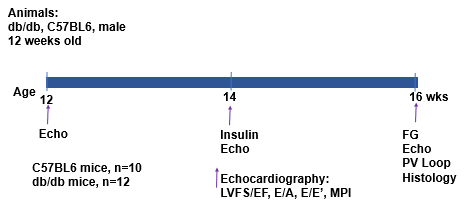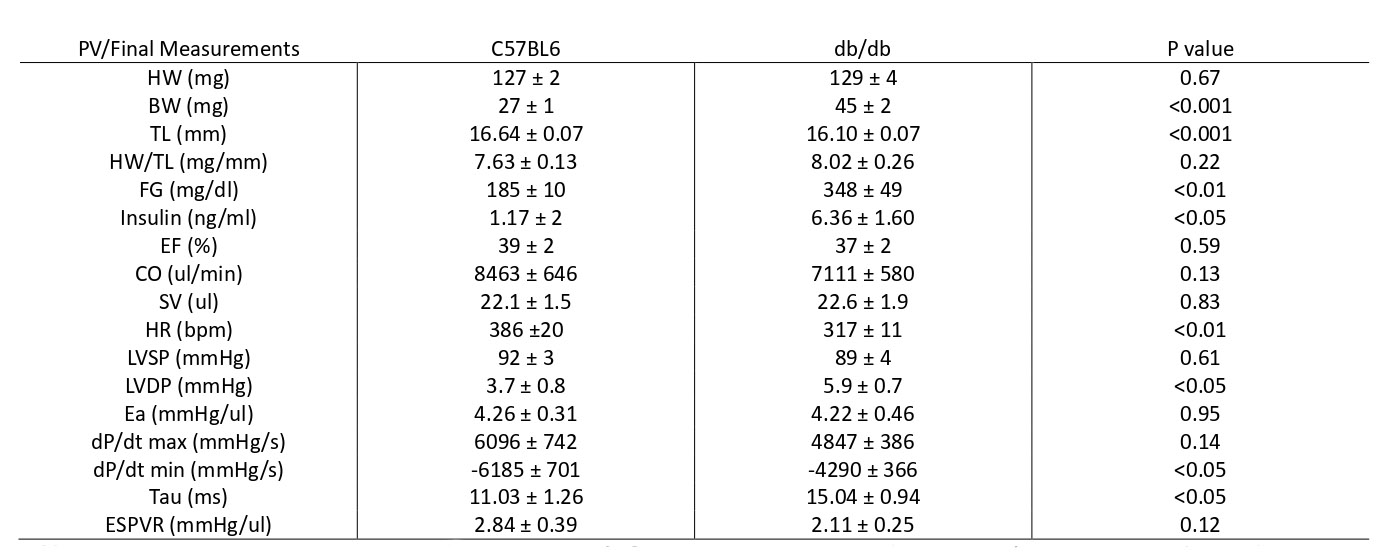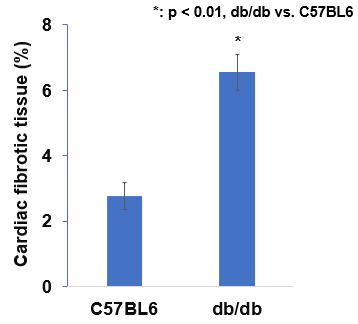DIABETIC CARDIOMYOPATHY Mice
Diabetic cardiomyopathy is generally characterized by adverse cardiac remodeling, a complication from poorly regulated diabetes. Frequently, there are findings of hypertrophy, fibrosis, and reduced diastolic function. This model can be represented in db/db mice.
Experimental Protocol

The db/db mice are monitored for cardiac remodeling at specific timepoints during the study. A non-invasive echocardiogram is performed at ages 12, 14, and 16 weeks. Insulin is tested at 14 weeks. Fasting glucose is tested at 16 weeks. A live pressure-volume loop is obtained at 16 weeks followed by final tests, measurements, sample collections, and histology.
Histology

Figure 1. Masson’s trichrome staining of left ventricle in C57BL6 and db/db mice. Blue staining indicates fibrosis, as seen increased around a blood vessel in the db/db mice
Echocardiography

Figure 2. Pulsed-wave Doppler (PWD) recording of left ventricular mitral inflow in a C57BL6 mouse showing a normal E/A ratio.

Figure 3. Pulsed-wave Doppler (PWD) recording of left ventricular mitral inflow in a db/db mouse showing an elevated E/A ratio indicating diastolic dysfunction.

Figure 4. Tissue Dopler (TDI) recording at the septal side of the mitral valve annulus in a C57BL6 mouse showing normal E’.

Figure 5. Tissue Dopler (TDI) recording at the septal side of the mitral valve annulus in a db/db mouse showing inverted E’/A’ with a reduced E’ contributing to an elevated E/E’. This is indicative of diastolic dysfunction.
Table 1. Echocardiogram parameters at baseline, 2 weeks, and 4 weeks in C57BL6 and db/db mice.

Abbreviations: IVSd, Interventricular Septum Thickness at end Diastole; LVEDd, Left-Ventricular End-Diastolic Dimension; LVPTd, Left-Ventricle Posterior Wall Thickness Diastole; IVSs, Interventricular Septum Thickness at end Systole; LVESd, Left-Ventricular End-Systolic Dimension; LVPTs, Left-Ventricle Posterior Wall Thickness Systole; FS, Fractional Shortening; EF, Ejection Fraction; LVM, Left Ventricular Mass; E/E’, Left Ventricular Diastolic Function; E/A, Left Ventricular Diastolic Function; IVRT, Isovolumetric Relaxation Time. All parameters are expressed as means ± the SEM. The P value was calculated by comparing the final echo between the C57BL6 and db/db mice.
Table 2. Pressure volume parameters and end measurements in C57BL6 and db/db mice.

Abbreviations: HW, Heart Weight; BW, Body Weight; TL, Tibia Length; FG, Fasting Glucose; EF, Ejection Fraction; CO, Cardiac Output; SV, Stroke Volume; HR, Heart Rate; LVSP, Left Ventricle Systolic Pressure; LVDP, Left Ventricle Diastolic Pressure; Ea, Arterial Elastance; dP/dt max, maximum derivative of change in systolic pressure over time; dP/dt min, minimum derivative of change in diastolic pressure over time; Tau, Left Ventricle Relaxation Constant; ESPVR, End-Systolic Pressure-Volume Relationship.
Sample Data

Figure 6. Percentage of cardiac fibrotic tissue in C57BL6 and db/db mice, *: p <0.01 db/db vs. C57BL6.
Diabetic cardiomyopathy is generally characterized by adverse cardiac remodeling, a complication from poorly regulated diabetes. Frequently, there are findings of hypertrophy, fibrosis, and reduced diastolic function.
Diabetic cardiomyopathy increases the risk of heart failure in people with diabetes. To develop effective treatment for heart failure, the Diabetic Cardiomyopathy Model allows us to better understand the pathophysiological mechanisms underlying the long-term complications of diabetes.
Transthoracic echocardiography allows for real-time analysis of cardiac remodeling throughout the study. Parasternal short axis (PSAX) view in B-Mode is most useful for visualizing the left ventricle structure and function. Using pulsed wave (PWD) and tissue Doppler (TDI), we are able to characterize left ventricle diastolic function.
Left ventricle catheterization to obtain live pressure-volume loop is performed terminally. It is extremely useful for acquiring accurate hemodynamic measurements.
Evidence of cardiac remodeling in the diabetic cardiomyopathy model model is supported using histology. Harvested organs with Masson’s trichrome staining help to identify regions and amount of fibrosis, indicated in blue.




